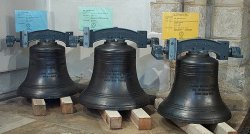
Practice night Mondays 7.30pm to
9.00pm.
Sunday ringing.

A Visit to the Whitechapel Bell Foundry (or "A walk through some Biblical Texts")
Recently, a small party of us eagerly caught the 10.55 am London train from Kettering to visit the Whitechapel Bell foundry. The purpose of the visit was to witness the new Barton Bells being cast. We were fortunate in arriving at St. Pancras fifteen minutes ahead of schedule (!), but alas! this time bonus soon evaporated when we were held up for forty minutes or so at Liverpool Street Station. The result of this delay was that we only just made it to the foundry in time.
The Whitechapel Bell Foundry is the oldest continuous private company in the world. A certain Rob Mot, who established the company, was casting bells in the 1570s - the date of our ancient four bells. Tradition has it that he originally came from Kent, where his father had started a highly successful scrap-metal business as a result of the removal and sale of bells following the dissolution of the monasteries. Robert came to London, and did founding of various types, including casting cannon for use against the Armada in 1588.
Among his finest bells are two at Westminster Abbey (dated 1583 and 1598 respectively), with the name of the dean inscribed on them, a Gabriel Goodman. Whitechapel have supplied many other bells to the City of London churches, including the famous Bow Bells (of St Mary-le-Bow): and Cheapside, the "Oranges and Lemons" Bells of St Clement Dames. The most famous bells produced at Whitechapel are "Big Ben" the clock bell in the tower of the Houses of Parliament, and the renowned "Liberty" Bell in America.
Bell founders in London congregated mostly on the eastern side of the city in the district between St Andrew Undershaft and St Botolph Aldgate, where Billiter Street yet remains to remind us of their industry, the word being a corruption of "bellyetere", the earliest English word in use to describe bell founding. (We had actually noticed Botolph Lane on our hurried walk to the Bell Foundry from the Tube station.) Did you know that our local bell foundry of Thomas Eayer (1710-1757) in Kettering during the eighteenth century was situated in the town's Bellfoundry Lane?
On arrival at the Foundry we were soon to be initiated to the craft of Bell Founding. The manufacture of a bell starts with an outer mould (known as a "cope") being fashioned from a mixture of sand, clay, horse manure, goat's hair and water. If any inscriptions are required these are now added to the inside surface of the cope.
An inner mould (or "core" as it is known) is formed in a similar way over a hollow brick foundation and when both are dry, the cope is clamped together over the core leaving a space corresponding to the precise size, shape and thickness of the bell to be made.
This making of cope and core reminded me of the prophet Jeremiah's words (Ch.18 vv2-4). Only when the moulds have been deemed to be perfect in the eyes of the (mould) maker is He satisfied. God shapes us and moulds us to what He wants us to be - "as it seems good". Jeremiah Ch. 18 vv5-6 reminds us of the fact that "Can I not do with you as the potter has done?" says the Lord.
The metal used for casting a bell is made from 77% copper and 23% tin. This is heated up in a furnace to 1170 Celsius (which is Centigrade to us oldies!). We had to stand back quite a distance from the furnace because of its intense heat - to me a vivid picture from Daniel Ch 3 vv19-23. (Look it up!). When the required temperature has been reached, and the metal was liquid, it was poured into a ladle and the "dross" or impurities raked off and discarded. These impurities actually float on the top of the molten metal, and if left would render the resultant casting imperfect, being full of pin-holes and producing an impaired musical note. This was a reminder to me of Malachi Ch. 3 vv2-3a - "for He the Lord is like a refiner's fire" etc. God can only use us when we have been purified and made clean (holy), so refining is necessary. (Numbers Ch31 vv 22&23: Ezekiel Ch22 vv 18-22).
The molten metal was then poured out of the ladle into the moulds and when each mould was nearly full a piece of magnesium was set alight. The brilliance from this light nearly dazzled us as magnesium burns with an intense white light. The reason for lighting the magnesium was to ensure that the final drops of molten metal did not cool too quickly and so produce an imperfect casting. The final stage of manufacturing, when the metal has been allowed to go cold (set) is to separate the cope from the core and tune the bell musically, using electronic equipment. This tuning ensures that the five harmonics (or 'ghost' notes) are true and perfect. The bell is finally cleaned up and polished.
During our visit to the foundry, a Dutch television crew were making a documentary programme on English bell founding; and actually recorded our bells being cast. As the outside of the copes were marked "Barton Seagrave" I wondered how many Dutch people would know where this place was in England and perhaps visit it! Maybe we shall have a follow-up visit from the Dutch television crew!! Who knows?
On our way home we all agreed that it had been a truly memorable and historic occasion in the history of our village.
Bill Hulme